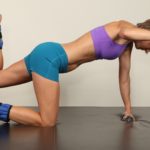Stretching is Essential For Life!
by CEO Robert Forster PT
The human body is a flesh and blood, mechanical machine that requires maintenance just like every other machine. You would never think that your car, lawnmower or bicycle could be used consistently, day in and day out, without some effort to keep it in good working order. Yet, on a daily basis, most people spend more time taking care of their teeth than they do the rest of their body. I’ve spent 40 years helping everyday and elite athletes get past injury to achieve their health and fitness goals, and I am certain that stretching is second only to movement itself and critical to maintaining good physical health. While athletes and those who exercise regularly have heard stretching is important, few understand why and most non-athletic people think they don’t need to stretch at all. The Forster Structure Program© now available online, is a step by step tutorial on the same stretching and strengthening program we use to correct and maintain structural health.Movement is Health
We were made to be in nearly constant motion. From early man up to the industrial revolution, our ancestors spent most of their waking hours in nearly constant movement. The need for food, water and shelter required it. Accordingly, for the body we have inherited, movement is vital to every bodily function from healthy digestion to proper brain function. Our bodies were engineered for very efficient movement although the largely sedentary lifestyle we have adopted since the industrial revolution has robbed us of the efficiencies built into this otherwise economical machine. The average American sits still for far too many hours every day to not expect problems. Ready to face the stark truth? Add up all your active hours and subtract those from 24, and you will see your sedentary time ranges from 18-20 hours a day. An average example: 7-8 hours of sleep every night, 1-3 hours commuting in the car, 6-8 hours at your desk and then home for TV on the sofa or some combination of sedentary activity. Without movement, tissues lose their extensibility and research shows that even those who spend 90 minutes a day at the gym experience detrimental changes at the cellular level with all the time spent motionless each day. Many of these sedentary hours are spent in the sitting position, which fights gravity to remain upright. In this slumped forward posture, the joints of the hips, shoulders and trunk, are rounded forward allowing the soft tissues in the front of our bodies to become tight over time. Poor posture begins as bad habits but becomes fixed as the connective tissue elements of our body adapt to the poor alignment. Joints operating in poor alignment suffer damage and premature aging. To understand why this occurs and how to prevent it we must take a look at the physiology of connective tissue.Tight Connective Tissue Locks Up Everything
To fully comprehend the importance of stretching we first need to understand that the target of any stretching program is not the muscle fibers themselves. Muscle fibers are elastic in nature and will stretch readily to many times their resting length. Instead it is the connective tissue structures in and around the muscles and joints that are resistant to stretch and the target of recommended stretching efforts. All connective tissue structures are made of collagen fibers arranged in specific patterns that dictate a particular structure’s strength and flexibility. While the bony skeleton provides the internal frame for the muscles to attach and provides protection for the vital organs, it is the connective tissue elements (also known the “soft skeleton”) that hold it all together like cellophane plastic wrap. Connective tissue gives our body it’s form and is integral to how it functions. Starting at the cellular level, we find every individual muscle fiber is wrapped in a collagen casing called fascia. Fascia also wraps groups of muscle fibers into bundles, and the bundles together to make up the muscle belly. Tendons, ligaments and joint capsules are also made of collagen and in many ways the connective tissue skeleton is so much more vital to health and function than the bony skeleton, but most people give it little thought. As Physical Therapists we spend our entire careers dealing with connective tissue and it’s dysfunction. A great deal of research has shown that collagen is constantly in a natural state of change. It adapts to the forces that it is exposed to; shoring itself up when it is exposed to stress and thinning out where it is not. In other words, it lengthens only when we demand it do so, and shortens if we leave it alone. This is called Davis’s law of connective tissue adaptation. But what you need to remember for your own health is that collagen’s natural tendency is to shorten over time if it is left un-stretched. As connective tissues shorten they limit the range of motion of the joint they surround. A joint with limited range of motion operates with poor mechanics even in the range of motion that is available. When joint mechanics falter, this leads to damage of the joint surfaces and other structures surrounding the joint.Stretching is the Medicine That Keeps us Moving
The number one reason we all need to stretch is to maintain proper joint function and mobility. Just like we brush our teeth to prevent decay, we need to stretch every day to prevent joint problems. For the sedentary person stretching is the bare minimum requirement to maintain physical health. For more active people and athletes, stretching is a critical practice that helps prevent injuries and promotes recovery by keeping muscles from shortening after workouts. For athletes looking to improve performance, stretching increases the range of motion of the bones around the joints allowing for the optimal execution of the bio-mechanics for their sport. I have worked with tens of thousands of athletes, from student athletes to pros and Olympic Champions, and none have reached their highest genetic potential without a sound flexibility routine.How Do I Stretch Correctly?
Time Efficient
For a stretching routine to be sustainable it has to be completed in 5-8 minutes before and after exercise. In the evening stretching to address problem areas and for relaxation can be accomplished in 12-15 minutes with longer holds and multiple repetitions.Stretch Before Every Workout
The strongest misconception about stretching is that it is dangerous to stretch the body when it is “cold”. I only agree with this statement in one condition: when you’re dead you don’t need to stretch! However, shy of death, our bodies are never actually “cold”. While collagen stretches better when the tissue is warmed up, it stretches just fine at the normal resting body temperature. To bear this out, all we need to do is look at dancers; ballerinas don’t go in the dance studio and run around to break a sweat before they stretch. The first thing they do is walk over to the bar, put their leg up, and stretch. And they generally have better flexibility than any other athlete. Yogis, martial artists, and gymnasts all have renowned levels of flexibility and the first thing they do is stretch, then warm up and stretch some more. As long as the stretching positions are safe, and we follow the “subsiding tension” principle, then stretching before workouts and competition is a safe and effective way to enhance performance and help avoid injury. Those who think they don’t need to stretch before workouts as long as they “start slow and warm up” are seriously misdirected or they may be just lazy. I hear this from time pressed coaches and athletes all the time, but the truth is if you don’t have time to stretch you don’t have time to workout!Stretch at the End of Every Workout:
Following workouts, the muscles are “pumped” i.e. left in a shortened state with blood vessels in and around the muscle laden with waste products of muscle physiology. Post workout static stretching promotes recovery by returning the muscle to its normal resting length while pulling the connective tissue taught to wring waste products out of the muscles and the associated vascular structures. Research has shown that stretching reduces delayed onset muscle soreness (DOMS) and allows us to recover quicker and workout again sooner and stronger.Relaxed Posture for Stretches:
Stretching is an act of relaxation. Muscles must be coaxed into lengthening and not slammed into it. The muscle fibers must be relaxed for the stretch to effectively target the connective tissue elements in and around them. Accordingly, each stretching posture must be chosen to promote relaxation and protect all the surrounding joints and especially those of the spine. Lower body muscles need to be relieved of their load, i.e. be non-weight bearing to allow the stretch to be effective. This can only be achieved by laying on the ground in positions that allow for muscle relaxation and easy breathing. For the upper body, the limb must be relaxed in a cradled or supported posture.Subsiding Tension Principle:
Muscles should be stretched slowly allowing the stretch sensation to register in the brain and then modulated by going deeper into the stretch or letting up based on that sensation. If the tension in the muscle increases while holding a position then one should let up a bit. If it decreases then move deeper into the stretch. Deep belly breathing will further relax the muscle and allow for the best result. Quick Release and Longer Hold Stretches:
Before and after activities, whether it’s workouts or housework, one need only to release the muscle to it’s normal resting length with two repetitions of each stretch for a 5-10 second hold. To improve flexibility, it’s best to hold the stretch a little longer and perform three repetitions of each posture. The longer holds to increase flexibility are better done after workouts or in the evening when our peripheral body temperature is naturally higher. Low intensity stretches, held for up to 60 seconds or longer, will result in a more permanent elongation of the collagen fibers and will improve the chronically tight areas of your body.Sport Specific Stretching:
This is an over blown concept. While certain parts of the body may need more or less attention to ready us for a given sport, in general all the big muscles must be addressed in every body, all the time. Furthermore there are only a few safe stretch positions for most of the larger muscle groups so when a volleyball player wonders why they are preforming the same stretches as the baseball player I tell them “you have a quadricep and so does he, and they both need to be stretched.” Additionally, there are problem areas in the human body that we all share and, therefore, need to be stretched in everyone. To avoid the common injuries of the spine, shoulders, pelvis and knees there is no getting around certain stretches that target our shared vulnerabilities.Static Stretching vs Dynamic Warm Up:
Recently many personal trainers and fitness professionals have been advising against static stretching based on a few studies supporting active or “dynamic warm up” versus static stretches for athletic performance. These few studies have shown that power and strength output were reduced immediately following static stretching. But, in my opinion, the studies were poorly designed and the findings misquoted and taken out of context. On the other hand, decades of research shows collagen lengthens best under long sustained stretching forces and that a static stretch results in the most permanent elongation of the tissue. Well-informed performance experts never meant for static stretching to be abandoned but instead augmented by dynamic movements as part of a well-designed pre-activity warm up. Stretching before workouts or competition allows athletes to execute the correct bio-mechanics of their sport and indeed my athletes have performed static stretching exercises immediately before stepping on the track, setting world records and wining gold medals.Stretching for Injury Prevention:
During exercise and in our daily activities the connective tissues are damaged under the stress of exertion. With adequate rest the body responds by laying down new collagen fibers to repair and shore up the tendons, fascia and ligaments under strain. This is how we become more resilient to injury. The new collagen fibers are laid down in a haphazard pattern at first and only become a meaningful “scar” with stretching and movement which stimulates the fibers to align themselves in a pattern that gives the scar strength in the required directions. Overuse injuries occur when further load is placed on the structure before the scar is matured, i.e. our activities have outpaced our ability to adapt to the stress. Stretching speeds up the processes of adaptation to avoid injury and improve recovery time by stimulating more functional scarring.Stretching for Relaxation:
At the end of a long workday muscle tension builds as we fight gravity to maintain upright postures and from the emotional stress of modern life. Stretching is the most natural and productive stress reliever. Stretching exercises, along with deep breathing, in relaxed postures allow us to release the stress from the muscle and this has been shown to decrease levels cortisol in the blood, a stress hormone that is problematic for health. The value of a regular stretching cannot be understated. Research aside, the best evidence for it’s use is derived from the clients we see in the clinic every day who solve chronic injuries and speed recovery from acute conditions with this simple remedy. The most gratifying feedback for any clinician is to see previous clients years later and they rattle off the stretches that fixed their earlier conditions and continue to serve them well decades later as they graduated from sprint triathlons to the Ironman distance, or 10k runners who progressed to the marathon and those who’s severe back pain is but a distant memory. Stay loose my friends! Here is Your At Home Forster Structure Program $29.99FORSTER STRUCTURE PROGRAM© STRENGTH AND FLEXIBILITY TRAINING from Robert Forster, PT on Vimeo.








